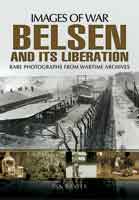The name Belsen is synonymous with a vision of hell. We automatically think of the pictures we’ve seen of the twisted bodies being thrown unceremoniously into huge hastily dug pits or the PatheNews reels of a Royal Engineer driving a bulldozer, scarf over mouth and nose to keep the stench out created as he pushes the corpses into giant heaps.
It’s relevant we have these images in mind, as this book is a photographic journal of one of Nazi Germany’s most notorious concentration camps.Some fifty thousand were said to have perished within the compounds of Belsen, most died of typhoid and other diseases, as there were no actual gas chambers at the camp. However, there were daily beatings and thousands died at the hands of their German and Hungarian guards, many of them brutal women recruited by the SS to dish out discipline and instill fear amongst the inmates.
The subject matter and history of the camp is a complex one and not one that is everyone’s subject of choice.I t’s purpose was to ‘hold’ enemies of the Reich; Russian POWs, criminals and, of course, Jews.
The thing with this book is it isn’t overwhelming to the reader. The photographs included have limited text so you’re encouraged to research further and you can’t help but sit and stare at the pictures and wonder and reel at their horror. The book starts with an insight into the SS and shows through the use of photographs how once normal human beings, fathers , husbands and sons were turned into brutal hands to aid the running of the camp.
Units of the British Second Army liberated the camp in April 1945 and the soldiers were both horrified and appalled at what they found. Many became angry and violent towards the SS guards that had remained to surrender. All were unprepared for this sort of warfare and one can only wonder at the lasting impression this had on many of the young British soldiers returning home to their families.
It’s also interesting to note that the piles of corpses and survivors in their inadequate striped uniforms are often classed as ‘ part of Belsen’ . It’s hard to imagine them as dignified human beings they all once were and one can only imagine the horror that was suffered by the survivors of the camp and how they all went to their graves, some many years later, without a day going by without a flashback or a moment of prayer for their friends and loved ones they watched die in their arms.
The book is well laid out. It almost has a schools or college text book feel about it at times especially with the last few pages left blank for notes. It’s hard hitting and doesn’t hold back and the inclusion of a Belsen staff list is gobsmacking! There’s even a list of guards who were tried and sentenced and it unashamedly lists their fate.
My only criticism, if you can call it that, is the inclusion of certain photographs of combat troops or troops in Uniform who may have been camp guards. I find this unnecessary and misleading especially the picture of Luftwaffe Flak troops or the pictures of Wehrmacht troops in combat. That’s just my opinion being a collector of German WW2 photographs myself, perhaps it’s necessary I mention it.
We’re living in an age when Germany is no longer held accountable for the Holocaust, but the blame falls squarely upon the Nazis. All said and done this is a great book written without apology and presented with respect and dignity.
This book is from the Images of Warseries and is just that: Images.
Reviewed by Phil Hodges for War History Online.
BELSEN AND ITS LIBERATION
Images of War
By Ian Baxter
Pen & Sword Military
ISBN: 978178133111
Pen&Sword
